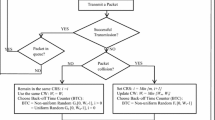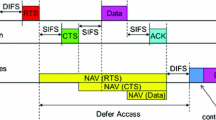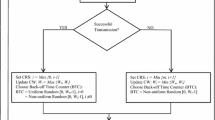Abstract
In this paper, we propose a mechanism named modified backoff (MB) mechanism to decrease the channel idle time in IEEE 802.11 distributed coordination function (DCF). In the noisy channel, when signal-to-noise ratio (SNR) is low, applying this mechanism in DCF greatly improves the throughput and lowers the channel idle time. This paper presents an analytical model for the performance study of IEEE 802.11 MB-DCF for nonsaturated heterogeneous traffic in the presence of transmission errors. First, we introduce the MB-DCF and compare its performance to IEEE 802.11 DCF with binary exponential backoff (BEB). The IEEE 802.11 DCF with BEB mechanism suffers from more channel idle time under low SNR. The MB-DCF ensures high throughput and low packet delay by reducing the channel idle time under the low traffic in the network. However, to the best of the authors’ knowledge, there are no previous works that enhance the performance of the DCF under imperfect wireless channel. We show through analysis that the proposed mechanism greatly outperforms the original IEEE 802.11 DCF in the imperfect channel condition. The effectiveness of physical and link layer parameters on throughput performance is explored. We also present a throughput investigation of the heterogeneous traffic for different radio conditions.
Similar content being viewed by others
References
Wireless LAN Medium Access Control (MAC) and Physical Layer (PHY) Specification, IEEE Standard 802.11, 1999.
G. Bianchi. Performance analysis of the IEEE 802.11 distributed coordination function. IEEE Journal on Selected Areas in Communications, vol. 18, no. 3, pp. 535–547, 2000.
K. Duffy, D. Malone, D. J. Leith. Modeling the 802.11 distributed coordination function in nonsaturated conditions. IEEE Communications Letters, vol. 9, no. 8, pp. 715–717, 2005.
D. Malone, K. Duffy, D. Leith. Modeling the 802.11 distributed coordination function in nonsaturated heterogeneous conditions. IEEE/ACM Transactions on Networking, vol. 15, no. 1, pp. 159–172, 2007.
T. D. Senthilkumar, A. Krishnan, P. Kumar. Nonsaturation throughput analysis of IEEE 802.11 distributed coordination function. In Proceedings of IEEE International Conference on Control Communication and Automation, IEEE, IIT Kanpur, India, pp. 154–158, 2008.
Y. S. Liaw, A. Dadej, A. Jayasuriya. Performance analysis of IEEE 802.11 DCF under limited load. In Proceedings of Asia-Pacific Conference on Communications, Australia, pp. 759–763, 2005.
X. Ling, L. X. Cai, J. W. Mark, X. Shen. Performance analysis of IEEE 802.11 DCF with heterogeneous traffic. In Proceedings of the IEEE Consumer Communication and Networking Conference, IEEE, Las Vegas, USA, pp. 49–53, 2007.
F. Alizadeh-Shabdiz, S. Subramaniam. A finite load analytical model for the IEEE 802.11 distributed coordination function MAC. In Proceedings of IEEE Workshop on Modeling and Optimization in Mobile, Ad Hoc and Wireless Networks, pp. 321–322, 2003.
A. N. Zaki, M. T. EI-Hadidi. Throughput analysis of IEEE 802.11 DCF under finite load traffic. In Proceedings of IEEE International Symposium on Control, Communication and Signal Processing, IEEE, Tunisia, pp. 535–538, 2004.
P. Chatzimisios, V. Vitsas, A. C. Boucouvalas. Throughput and delay analysis of IEEE 802.11 protocol. In Proceedings of IEEE International Workshop on Network Appliances, Liverpool, UK, pp. 168–174, 2002.
Y. Barowski, S. Biaz, P. Agrawal. Towards the performance analysis of IEEE 802.11 in multi-hop ad-hoc networks. In Proceedings of IEEE Wireless Communications and Networking Conference, IEEE, Las Angels, USA, pp. 100–116, 2005
F. Daneshgaran, M. Laddomada, F. Mesiti, M. Mondin. Unsaturated throughput analysis of IEEE 802.11 in presence of non ideal transmission channel and capture effects. IEEE Transactions on Wireless Communications, vol. 7, no. 4, pp. 1276–1286, 2008.
H. Minooei, H. Nojumi. Performance evaluation of a new backoff method for IEEE 802.11. Computer Communications, vol. 30, no. 18, pp. 3698–3704, 2007.
P. Chatzimisios, A. C. Boucouvalas, V. Vitsas. Performance analysis of IEEE 802.11 DCF in presence of transmission errors. In Proceedings of IEEE International Conference on Communication, IEEE, vol. 7, pp. 3854–3858, 2004.
X. J. Dong, P. Varaiya. Saturation throughput analysis of IEEE 802.11 wireless LANs for a lossy channel. IEEE Communications Letters, vol. 9, no. 2, pp. 100–102, 2005.
A. Shamhat, Z. Altman, B. Fourestie. Performance analysis of the IEEE 802.11 DCF with imperfect radio conditions. In Proceedings of IEEE International Conference on Wireless and Mobile Communication, IEEE, Bucharest, Rome, pp. 27–32, 2006.
Y. Zheng, K. Lu, D. Wu, Y. Fang. Performance analysis of IEEE 802.11 DCF in imperfect channels. IEEE Transactions on Vehicular Technology, vol. 55, no. 5, pp. 1648–1656, 2006.
J. He, H. K. Pung. Performance modelling and evaluation of IEEE 802.11 distributed coordination function in multi-hop wireless networks. Computer Communications, vol. 29, no. 9, pp. 1300–1308, 2006.
T. D. Senthilkumar, A. Krishnan, P. Kumar. New approach for throughput analysis of IEEE 802.11 in Adhoc networks. In Proceedings of IEEE International Conference on Control Communication and Automation, IEEE, IIT Kanpur, India, pp. 148–153, 2008.
N. Song, B. Kwak, N. Song, Miller. Enhancement of IEEE 802.11 distributed coordination function with exponential increase exponential decrease backoff algorithm. In Proceedings of IEEE Vehicular Technology Conference, IEEE, Florida, USA, vol. 4, pp. 2775–2778, 2003.
C. Wang, B. Li, L. Li. A new collision resolution mechanism to enhance the performance of IEEE 802.11 DCF. IEEE Transactions on Vehicular Technology, vol. 53, no. 4, pp. 1235–1246, 2004.
J. Yin, X. Wang, D. P. Agrawal. Optimal packet size in error-prone channel for IEEE 802.11 distributed coordination function. In Proceedings of IEEE Wireless Communication and Networking Conference, IEEE, Atlanda, USA, vol. 3, pp. 1654–1659, 2004.
Y. Kwon, Y. Fang, H. Latchman. A novel MAC protocol with fast collision resolution for wireless LANs. In Proceedings of the 22nd Annual Joint Conference of the IEEE Computer and Communications, IEEE, San Francisco, USA, vol. 2, pp. 853–862, 2003.
M. S. Hasan, C. Harding, H. Yu, A. Griths. Modeling delay and packet drop in networked control systems using network simulator NS2. International Journal of Automation and Computing, vol. 2, no. 2, pp. 187–194, 2005.
S. Haykin. Digital Communications, New York, USA: John Wiley&Sons, 1988.
J. G. Proakis. Digital Communications, New york, USA: McGraw Hill, 2001.
The network simulator-ns-2, [Online], Available: http://www.isi.edu/nsnam/ns/, June 26, 2008.
Author information
Authors and Affiliations
Corresponding author
Additional information
Dhanasekaran Senthilkumar received the B. Eng. degree from Bharathiar University, Coimbatore, India in 1997, and the M. Tech. degree from Sastra University, Tanjavore, India in 2002. From 2002 to 2007, he worked as a lecturer in K. S. Rangasamy College of Technology, Tamilnadu, India. He is currently a Ph. D. candidate in Anna University, Chennai, India. He is a member of IETE and ISTE.
His research interests include performance analysis and quality of service of wireless local area networks.
A. Krishnan received the Ph.D. degree from Indian Institute of Technology Kanpur, Kanpur, India. He is currently a professor with K. S. Rangasamy College of Technology, Tiruchengode, Tamilnadu, India. He is a member of IEEE, IETE, and ISTE.
His research interests include quality of service of high-speed networks, signal processing, and network security.
Rights and permissions
About this article
Cite this article
Senthilkumar, D., Krishnan, A. Nonsaturation throughput enhancement of IEEE 802.11b distributed coordination function for heterogeneous traffic under noisy environment. Int. J. Autom. Comput. 7, 95–104 (2010). https://doi.org/10.1007/s11633-010-0095-6
Received:
Revised:
Published:
Issue Date:
DOI: https://doi.org/10.1007/s11633-010-0095-6




